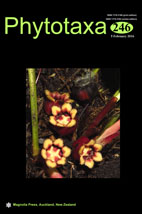Abstract
During an exploration in the virgin subalpine forest of Sikkim Himalaya, an undescribed edible mushroom, Ramaria subalpina (Basidiomycota, Gomphales) was gathered along with other macrofungi. It is characterized by the combination of characters: solitary to gregarious basidiomata with stipe (surface) that becomes blood red at base after bruising or on maturity, brownish red to violet brown ultimate branch tips, rarely clamped generative hyphae and putative association with Abies in subalpine Himalaya. Detailed taxonomic information of this novel species is described and illustrated. Morphologically and phylogenetically allied Indian and extralimital taxa are compared. A provisional key to the similar species of Ramaria, previously reported from India, is also provided.

